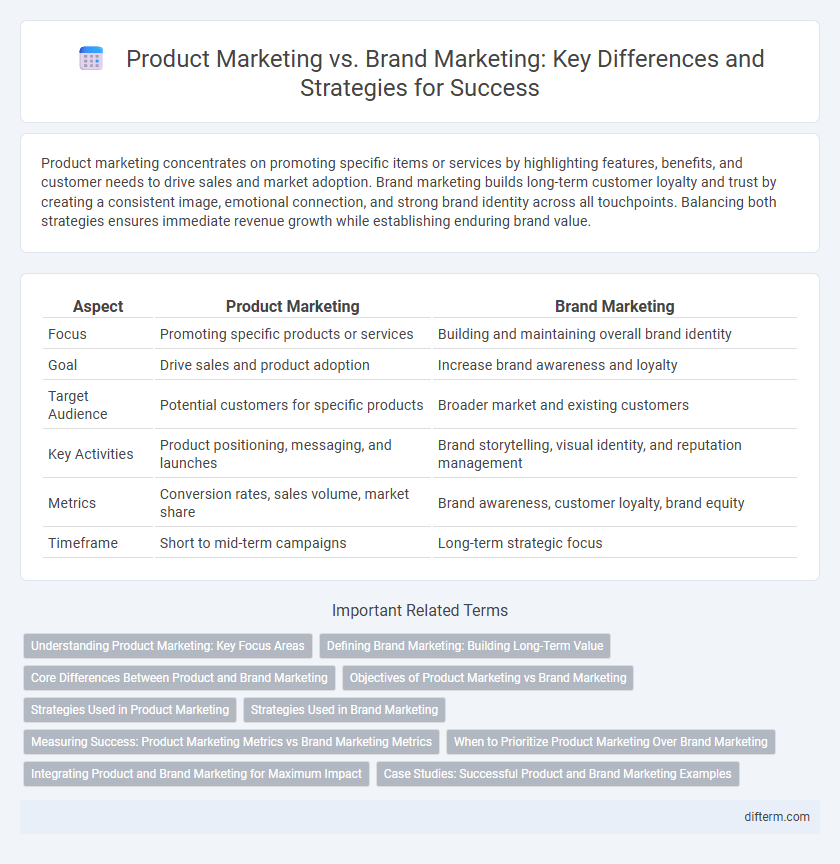Product marketing concentrates on promoting specific items or services by highlighting features, benefits, and customer needs to drive sales and market adoption. Brand marketing builds long-term customer loyalty and trust by creating a consistent image, emotional connection, and strong brand identity across all touchpoints. Balancing both strategies ensures immediate revenue growth while establishing enduring brand value.
Table of Comparison
| Aspect | Product Marketing | Brand Marketing |
|---|---|---|
| Focus | Promoting specific products or services | Building and maintaining overall brand identity |
| Goal | Drive sales and product adoption | Increase brand awareness and loyalty |
| Target Audience | Potential customers for specific products | Broader market and existing customers |
| Key Activities | Product positioning, messaging, and launches | Brand storytelling, visual identity, and reputation management |
| Metrics | Conversion rates, sales volume, market share | Brand awareness, customer loyalty, brand equity |
| Timeframe | Short to mid-term campaigns | Long-term strategic focus |
Understanding Product Marketing: Key Focus Areas
Product marketing centers on understanding customer needs, positioning products effectively, and driving adoption through targeted messaging and competitive analysis. It involves collaboration with sales, marketing, and product teams to develop go-to-market strategies that maximize product success and revenue growth. Key areas include product launch execution, market segmentation, and customer feedback integration to refine product offerings continuously.
Defining Brand Marketing: Building Long-Term Value
Brand marketing focuses on creating a strong, consistent identity that resonates emotionally with consumers, enhancing brand recognition and loyalty over time. It emphasizes storytelling, core values, and a compelling brand promise to build enduring connections that transcend individual products. This long-term approach drives sustained customer trust, enabling premium pricing and competitive differentiation in the marketplace.
Core Differences Between Product and Brand Marketing
Product marketing centers on promoting specific features, benefits, and uses of a product to target customers, driving sales and adoption within defined market segments. Brand marketing focuses on building overall brand identity, emotional connection, and long-term loyalty by shaping perceptions and establishing trust across diverse audiences. The core difference lies in product marketing's short-term, tactical sales goals versus brand marketing's long-term, strategic reputation and equity development.
Objectives of Product Marketing vs Brand Marketing
Product marketing focuses on promoting specific products to drive sales, emphasizing features, benefits, and customer needs to achieve short-term revenue goals. Brand marketing aims to build long-term brand equity by creating emotional connections, brand awareness, and loyalty among target audiences. While product marketing targets immediate market demand, brand marketing seeks to establish a consistent brand identity and market position over time.
Strategies Used in Product Marketing
Product marketing strategies prioritize market research, customer segmentation, and value proposition development to effectively position a product and drive demand. Key tactics include competitive analysis, product launches, pricing strategies, and targeted messaging tailored to specific buyer personas. Emphasizing feature benefits, use cases, and customer feedback helps optimize product-market fit and accelerate sales cycles.
Strategies Used in Brand Marketing
Brand marketing strategies focus on building long-term customer loyalty and emotional connections through consistent messaging, storytelling, and visual identity across all channels. Emphasizing brand values and customer experience, these strategies leverage social media engagement, influencer partnerships, and content marketing to enhance brand awareness and trust. Strategic brand positioning differentiates the company within competitive markets, creating a recognizable and relatable brand image that drives sustainable growth.
Measuring Success: Product Marketing Metrics vs Brand Marketing Metrics
Product marketing success is measured through metrics such as customer acquisition cost (CAC), conversion rates, and product usage statistics, which directly reflect market demand and product performance. Brand marketing metrics focus on brand awareness, brand equity, and customer loyalty, capturing the long-term value and perception of the brand in the marketplace. Combining product marketing metrics with brand marketing insights provides a comprehensive understanding of both immediate sales impact and sustained brand strength.
When to Prioritize Product Marketing Over Brand Marketing
Prioritize product marketing over brand marketing when launching a new product or entering a competitive market to emphasize features, benefits, and unique selling points that drive immediate customer acquisition. Focus on product marketing during short-term sales campaigns or seasonal promotions to generate quick, measurable results and increase conversion rates. Use data-driven insights to tailor messaging toward specific customer needs and product performance, ensuring that the marketing efforts directly impact purchase decisions.
Integrating Product and Brand Marketing for Maximum Impact
Integrating product marketing and brand marketing enhances customer engagement by aligning product features with brand values, creating a cohesive narrative that drives both awareness and conversion. Leveraging data insights from product marketing helps refine brand messaging, ensuring it resonates with target audiences while maintaining consistent identity across channels. This synergy maximizes marketing ROI by fostering deeper emotional connections and clear value propositions that elevate market positioning.
Case Studies: Successful Product and Brand Marketing Examples
Case studies reveal that Apple's product marketing for the iPhone emphasizes features, user experience, and innovation, driving significant sales growth and customer loyalty. In contrast, Coca-Cola's brand marketing focuses on emotional connection and brand identity, creating a globally recognized image that fosters long-term consumer trust. These examples demonstrate how targeted strategies in product and brand marketing can effectively achieve distinct business objectives.
Product marketing vs brand marketing Infographic

 difterm.com
difterm.com